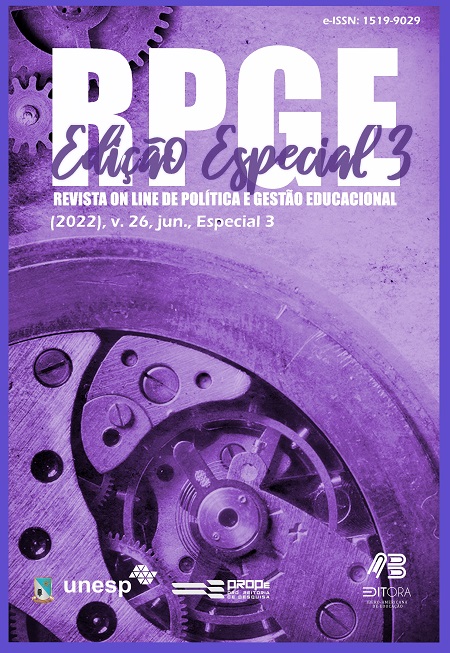The digital coexistence and its problems
A study with adolescents from São Paulo State public schools
DOI:
https://doi.org/10.22633/rpge.v26iesp.3.16957Keywords:
Virtual interaction, Empathy Coexistence, Pandemic, InternetAbstract
The forms of coexistence are crossed by multiple variables, so that the current technological apparatuses not only mark the interactions between people but also build different forms of relationships in contemporaneity. In this way, physical and virtual environments merge, configuring possibilities of real coexistence that impact on relationships between people, especially in pandemic times in which interpersonal relationships mediated by virtual platforms have been greatly enhanced. Recognizing this reality, it is urgent to reflect on: How does the coexistence between adolescents occur in virtual environments? What are the biggest difficulties of coexistence that does not include physical contact? Aiming to reflect on these questions, a descriptive study was conducted on cyber coexistence/cyber aggression seeking to identify how the behaviors and interactions occurring in virtual environments are characterized. The instrument for data collection was a structured questionnaire, containing 15 questions about the theme, applied virtually through a form via Google Forms. The participants of the study comprised a sample of 1,923 adolescents, students from two directorates of the São Paulo state public school system: the DRE "Leste 3" in the metropolitan region of São Paulo with 1,056 respondents and the DRE of Taquaritinga, in the countryside of São Paulo, with 867 adolescents. We found a sample of almost 40% of students responding that they had already been insulted in virtual interactions, experiencing pain and suffering in this form of coexistence.
Downloads
References
ALAMILLO, R.; PÉREZ, M. Chaves para prevenir o bullying e o "cyberbullying": Melhorando a convivência e a "cibercoexistência" em ambientes escolares. Participação Educativa, v. 5, n. 8, p. 129-143, 2018. Disponível em https://dialnet.unirioja.es/servlet/articulo?codigo=6785346. Acesso em: 05 abr. 2022.
AVILÉS, J. Pandemia y convivencia escolar: Incertidumbres y retos. Revista Tópicos Educacioais, v. 27, n. 1, p. 1-21, 2021. Disponível em: https://www.redalyc.org/journal/6727/672770961001/672770961001.pdf. Acesso em: 10 dez. 2021.
AVILÉS, J. M. M. Bullying: Guia para educadores. Campinas, SP: Mercado de Letras, 2013.
BANDURA, A. Moral disengagement in the perpetration of inhumanities. Personality and Social Psychology Review, v. 3, n. 3, p. 193-209, 1999. Disponível em: https://journals.sagepub.com/doi/10.1207/s15327957pspr0303_3. Acesso em: 10 maio 2021.
BAUMAN, Z. A sociedade individualizada: Vidas contadas e histórias vividas. Rio de Janeiro: Zahar, 2008.
DEMPSEY, A. G. et al. Has Cyber Technology Produced a New Group of Peer Aggressors? Cyberpsychology, Behavior, and Social Networking, v. 14, n. 5, 2011. Disponível em: https://www.liebertpub.com/doi/abs/10.1089/cyber.2010.0108. Acesso em: 23 ago. 2021.
GARAIGORDOBIL, M. et al. Cyberaggression in Adolescents of Bolivia: Connection with Psychopathological Symptoms, Adaptive and Predictor Variables. International Journal of Environmental Research and Public Health, n. 17, n. 3, 1022, 2020. Disponível em: https://www.mdpi.com/1660-4601/17/3/1022. Acesso em: 15 jul. 2021.
LÉVY, P. O que é o virtual? São Paulo: Editora 34, 2011.
LIVINGSTONE, S. Risco online, danos e vulnerabilidade: Reflexões sobre a base de evidências para a política de segurança da Internet infantil. Zer, v. 18, n. 35, p. 13-28, 2013. Disponível em: https://ojs.ehu.eus/index.php/Zer/article/view/10667. Acesso em: 12 dez. 2021.
SIBILIA, P. O show do eu: A intimidade como espetáculo. 2. ed. Rio Janeiro: Contraponto, 2016
IBGE. Instituto Brasileiro de Geografia e Estatística. Pesquisa nacional por amostra de domicílios: Pnad Contínua. Rio de Janeiro: IBGE, 2018. Disponível em: https://biblioteca.ibge.gov.br/visualizacao/livros/liv101705_informativo.pdf. Acesso em: 14 fev. 2021.
TIC KIDS ONLINE. Pesquisa sobre o uso da internet por crianças e adolescentes no Brasil: 2018. São Paulo: Comitê Gestor da Internet no Brasil, 2019.
Published
How to Cite
Issue
Section
License
Copyright (c) 2022 Revista on line de Política e Gestão Educacional

This work is licensed under a Creative Commons Attribution-NonCommercial-ShareAlike 4.0 International License.
Manuscritos aceitos e publicados são de propriedade da Revista on line de Política e Gestão Educacional. É vedada a submissão integral ou parcial do manuscrito a qualquer outro periódico. A responsabilidade do conteúdo dos artigos é exclusiva dos autores. É vedada a tradução para outro idioma sem a autorização escrita do Editor ouvida a Comissão Editorial Científica.











